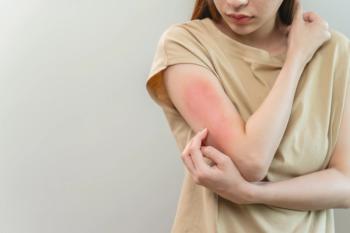
Cardiovascular Risk Significantly Greater in Patients With Psoriatic Disease
A significantly greater risk of cardiovascular events was observed among a multiethnic Brazilian population of patients with psoriasis and psoriatic arthritis vs controls, in which those in the sixth decade of life had the highest risk.
A significantly greater risk of cardiovascular events was observed among a multiethnic Brazilian population of patients with psoriatic disease vs controls, according to study findings published in
Cited by researchers as the leading cause of death worldwide, cardiovascular disease has been associated with psoriatic disease, including psoriasis and psoriatic arthritis (PsA), particularly risk factors such as obesity, hypertension, diabetes, dyslipidemia, and smoking.
“Studies have tried to identify whether psoriatic disease per se is a cardiovascular risk (CVR) factor based on the similarity between its inflammatory events and those found in atheromatous plaques,” noted the study authors.
They conducted a cross-sectional study of outpatients with psoriasis and PsA followed between June 2019 and December 2020 at the Dermatology Outpatient Clinic of the University Hospital of the Federal University of Rio de Janeiro, Brazil, to investigate the CVR in a multiracial patient population living in a tropical climate. The Framingham Risk Score (FRS) was used for patients with psoriatic disease to predict cardiovascular events over 10 years, compared with controls.
“Using clinical and laboratory variables, it stratifies the CVR in low, medium or high within 10 years in subjects aged between 30 and 74 years. High-risk patients deserve clinical intervention,” researchers explained. “FRS values less than 10% were considered low risk, values between 10% to 20% moderate risk, and values greater than 20% high risk.”
A total of 189 individuals matched by sex and age were recruited for the analysis and divided into 3 groups: psoriasis (n = 45; mean [SD] age, 54 [11.7] years; 53.3% male), PsA (n = 63; mean [SD] age, 58 [10.4] years; 31.7% male), and controls (n = 81; mean [SD] age, 51.9 [11.4] years; 44.4% male). CVR factors collected for each subject included age, gender, systolic blood pressure, total cholesterol and high-density lipoprotein (HDL) cholesterol serum levels, smoking habit, diabetes mellitus, and systemic hypertension status.
Among the study cohort, mean (SD) FRS was significantly higher in patients with psoriasis and PsA compared with controls at 10 years (16.3 [14] and 18.0 [15] vs 10.6 [9.5], respectively; P = .01). Moreover, the 10-year absolute FRS in the psoriasis, PsA, and control groups was high in 26.7%, 36.5%, and 13.6% of patients, respectively (P < .001).
CVR was shown to increase with age, as the frequency of high FRS was highest in the sixth decade of life (60 to 74 years) for the psoriasis (mean [SD] FRS, 26 [15]), PsA (25.6 [17]), and control groups (18.9 [10]) (P = .01).
Compared with controls, the chance of having a high FRS in the psoriasis and PsA groups increased by 0.299 and 0.233 times per year, respectively.
“Estimating CVR is a difficult task, and a major challenge in preventing CVE in the general population. This challenge is much greater in PD, which is inflammatory and systemic,” concluded researchers. “Therefore, CVR assessment should be part of the holistic treatment of all patients in an attempt to prevent and treat CVE.”
Reference
Mazzillo M, Accioly PG, Camargo C, et al. Evaluation of cardiovascular risk in patients with psoriatic disease in a multiracial population: a cross-sectional study. Clin Exp Dermatol. Published online April 18, 2022. doi:10.1111/ced.15233
Newsletter
Stay ahead of policy, cost, and value—subscribe to AJMC for expert insights at the intersection of clinical care and health economics.









































